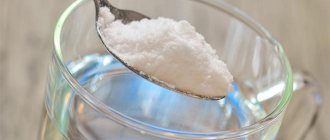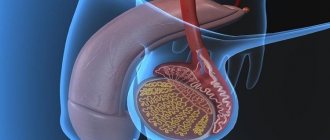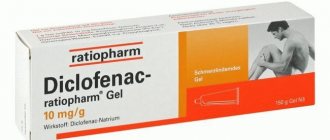In the post-Soviet space it is difficult to find a person who is not familiar with the pale purple solution of potassium permanganate. They wash wounds with it, use it internally, and use it for tanning leather.
If used incorrectly, potassium permanganate can be dangerous. That is why it is so important to know how potassium permanganate is used for poisoning, what concentration of the solution allows you to treat traumatic injuries, and how the drug acts on the human body.
Potassium permanganate is one of the inexpensive and effective means to combat poisoning!
Potassium permanganate - what is it
The chemical drug potassium permanganate is classified as an oxidizing agent. The product consists of dark purple crystals. When diluted, the water acquires a bright red or deep purple hue. Range of applications – industry, medicine, manufacturing. The solution is also in demand at home.
Every family tries to keep this powder in their home medicine cabinet. Previously, potassium permanganate was sold freely in pharmacies. But for the last 10 years it has been sold only by prescription. The restriction is associated with the use of powder in the clandestine production of narcotic drugs. Potassium permanganate has a short shelf life - 1 year.
When the solution enters the stomach, a chemical reaction occurs to release active oxygen, which acts as an antiseptic. This property is beneficial for home use.
Methods of using potassium permanganate
In toxicology, potassium permanganate is used for:
Gastric lavage;
Ingestion to bind toxins;
Ingestion as a fixative;
Taken orally as an emetic.
It should be understood that the concentration of the solution for each of the above purposes is different.
Gastric lavage
Schematic representation of the gastric lavage procedure
The algorithm for gastric lavage using potassium permanganate does not differ from that with ordinary water.
The solution for the procedure is prepared as follows:
- Take the required amount of clean water (up to 10 liters for probe rinsing, up to 3-4 for “restaurant” rinsing);
- Potassium permanganate is added at the rate of several crystals per liter of water;
- The composition is thoroughly mixed and poured into another container through several layers of gauze.
The exact dosage instructions are given in the table below. The finished solution should have a dark pink (not burgundy) color, but at the same time remain transparent. In case of poisoning, it is better to leave the potassium permanganate solution light pink for children.
When diluting potassium permanganate, you must ensure that it is completely dissolved. Undissolved crystals of the drug, if they come into contact with the mucous membrane, will cause a burn.
On a note! It is better to dilute KMgO4 in warm water. This way the powder dissolves faster and more completely.
Ingested to bind toxins and combat diarrhea
Colors of potassium permanganate solutions.
From left to right: toxic solution, concentration for gastric lavage, for vomiting, for relief of diarrhea. The rightmost glass is the control glass. It contains clean water.
The question of whether it is possible to drink potassium permanganate in case of poisoning is controversial. According to some sources, potassium permanganate does not lead to relief of the patient's condition. However, extensive practical experience in using the drug in folk medicine indicates the opposite.
For oral administration, the solution is prepared in a manner similar to that described in the previous section. The color of the liquid should remain pale pink, as for children. The volume of medication required for one dose is 100-150 ml.
Potassium permanganate is taken once. Under its influence, pathogenic microflora is destroyed and inorganic toxins are bound. This is also responsible for the antidiarrheal effect of the drug.
The drug kills “bad” bacteria in the intestines
Do not increase the concentration of the solution intended for drinking. Too high a content of the active ingredient will cause vomiting, which completely eliminates the antitoxic and fixing effect. You can learn more about how to dilute potassium permanganate in case of poisoning from the video in this article.
Ingestion to induce vomiting
The emetic effect of potassium permanganate solution is due to the unpleasant taste of the drug, as well as its irritating effect on the stomach receptors. The color of the liquid should be slightly darker than when treating diarrhea. The drug is taken once, before gastric lavage or instead of it. The volume of the solution is 200-250 ml.
Potassium permanganate dosage table depending on your goals:
| Procedure | Amount of KMgO4 in crystals | Water volume |
| Gastric lavage | 10 crystals | 1000 ml |
| Use internally to combat diarrhea | 2 crystals | 200-250 ml |
| Ingestion as an emetic | 4 crystals | 200-250 ml |
The healing effect of potassium permanganate
Manganese solution should be taken exclusively to rinse the gastric cavity. This will help trigger the gag reflex. Harmful toxins and pathogens will leave the stomach along with the vomit. The remaining toxic substances will be blocked and will not cause harm to the patient.
Use for children is prohibited. Manganese provokes severe vomiting, which brings pain. The child may experience a burn to the mucous membrane of the respiratory tract.
In case of poisoning, potassium permanganate is used in extremely weak concentrations. A highly concentrated infusion will provoke chemical intoxication and irritation of the membranes of the digestive organs. Many doctors advise using saline or soda solution for rinsing.
What can replace the product (analogs)
Unfortunately, potassium permanganate is not present in every home. There are other options for medicinal liquid agents used for poisoning. In children, treatment is carried out using similar solutions.
What you can do:
- The washing procedure can be carried out with clean boiled water at room temperature. For treatment you will need up to five liters of water.
- Soda solution will help with various types of poisoning. To prepare, dilute a tablespoon of soda powder in a liter of water.
- For rinsing, it is allowed to use saline solution at a concentration of 0.9%.
- It is allowed to use liquid mixtures with sorbents - activated carbon, polysorb, enterosgel.
- A saline solution will help to cope perfectly with toxins in the stomach - take two large spoons of salt for five liters of water. (lethal dose of salt)
We recommend: How to take sodium thiosulfate to cleanse the body?
The choice of remedy is up to the person, but it is always necessary to take into account the condition of the victim and the product that caused the intoxication.
When to use
To free the stomach from toxic compounds, it is recommended to use water with a small amount of permanganate - the water turns a slightly pinkish color. Skin wounds and burns are treated with a strong solution of potassium permanganate. Purulent formations on the wound are also treated with a highly concentrated infusion.
Lavage of the gastric mucosa is required if:
- When food poisoning occurs, a symptom is nausea or vomiting.
- You need to get rid of poisoning from counterfeit alcohol and cheap drinks.
- Intoxication with phosphorus or quinine, hydrocyanic acid, or alkali develops.
A person with a severe allergic reaction to potassium permanganate should not rinse the gastric mucosa. Possible side effects: urticaria and allergic bronchitis or rhinitis.
Children and teenagers under 18 years of age should use the infusion only on the recommendation of the attending physician. The dose is calculated carefully so as not to harm the body. Infants are usually bathed in water with potassium permanganate. This disinfects and protects the skin well.
You should not drink the solution to relieve symptoms of poisoning. It can cause complications in the well-being of the victim. The use of manganese is strictly on the recommendation of a doctor.
Application of potassium permanganate
Severe intoxication of the body with organic or inorganic compounds requires urgent measures to remove the poison. Before the ambulance arrives, the victim’s stomach is washed and a gag reflex is provoked. Previously, water with potassium crystals was used. Now doctors recommend saline or soda solution. But many still use the usual method. Potassium permanganate is more effective than salt and has antiseptic properties.
In case of alcohol poisoning, the use of potassium permanganate makes chemical compounds and alcohol derivatives safe or completely blocks their effect.
In case of bacterial intoxication or microbial damage, pathogenic microorganisms die.
In exceptional cases, doctors recommend drinking potassium permanganate in extremely weak concentrations.
Application
Potassium permanganate is a solid crystalline substance of purple, almost black color. The compound has good solubility in water. Due to its antibacterial properties and ability to destroy pathogenic organisms, it has found application in medicine.
When taken, zinc oxide is formed, which forms a film on the mucous membranes of the stomach and intestines. This action protects organs from penetration of pathogenic bacteria.
The shelf life of the drug is limited. If the compound is stored in glass, the shelf life is five years. However, in case of poisoning, it is recommended to use the product fresh to obtain an effective solution. The prepared medicine is not stored for a long time; it quickly loses its beneficial properties.
Currently, it is almost impossible to buy potassium permanganate; dispensing is carried out only upon presentation of a prescription. This is due to the fact that the compound is used to create narcotic and explosive drugs.
What effect does potassium permanganate have on poisoning? Why is it used in adults and children?
Action:
- Promotes the gag reflex, kills toxic bacteria,
- In case of poisoning with certain types of poisons, potassium permanganate is able to neutralize them, turning them into compounds that do not pose a danger.
A solution of potassium permanganate is not recommended for use in cases of poisoning in children to avoid burns from accidental inhalation of vapors of the substance. Babies are not always able to provoke vomiting; prolonged presence of liquid in the stomach can also lead to burns.
Dosage
At home, the solution is prepared based on the color of the water. It should turn a slightly noticeable pink color. This approximately equals a concentration of 0.01 – 0.1%. Washing with such an infusion will not cause harm to the body. To obtain the indicated concentration, you will need 4 crystals of potassium permanganate and a liter of water.
Rich raspberry and purple colors are present in the strong infusion. This remedy cannot be used for self-medication - it will cause a painful chemical burn. Application requires medical supervision.
To dilute the powder, it is recommended to take chilled boiled and distilled water. Use only transparent and glass containers. Mix everything thoroughly, pass the resulting liquid through cheesecloth (fold in 8 layers). Undissolved crystals will remain on the tissue and will not cause harm to the mucous membrane.
Ingestion of a strong infusion provokes methemoglobinemia - hypoxia of internal organs, more kidney tissue suffers.
Gastric lavage process
The procedure for cleansing the stomach of toxins has certain rules and procedures for use:
- It is not recommended to prepare excess infusion - 1 liter is enough.
- You need to drink the solution while sitting.
- The manganese infusion inside begins to act within a minute, you will have to wait.
- After 2-3 minutes, the gag reflex should begin; if not, induce it artificially.
- To completely cleanse the stomach, you will need 3 liters of liquid - you need to drink 0.5 liters at a time.
- If you want to induce diarrhea, you need to do an enema with potassium permanganate.
How to rinse the stomach with potassium permanganate?
A solution of potassium permanganate for gastric lavage is used gradually. For the first use, 500-600 ml is enough. The patient should drink the liquid in small sips, listening to his feelings. If vomiting does not start after a few minutes, it will have to be induced by pressing your fingers on the root of the tongue.
If the vomit contains food, you need to drink potassium permanganate again. The procedure is repeated several times until the liquid leaving the stomach becomes clear. After each vomiting, rinse your throat and mouth with clean water.
Safety rules when working with potassium permanganate
Manganese reacts easily with almost all substances found in nature. Therefore, it is recommended to follow the rules for working with powder:
- Remove crystals that have not dissolved from the solution.
- Prevent the penetration of grains of potassium permanganate into the mucous membrane of the respiratory tract.
- Mandatory use of transparent and glass containers.
- The infusion cannot be stored - it must be used immediately.
- Potassium permanganate should be kept away from open flames as the crystals may explode.
Potassium permanganate crystals
- Give to the patient only on the recommendation of a doctor.
- If the powder gets on the skin of your hands, you need to thoroughly rinse the affected areas.
- Avoid contact with sugar, explosive substances and sand.
- If a large area of skin is damaged, permanganate cannot be used.
Gastric lavage with manganese is not recommended for children - it can cause intoxication or tissue burns. It is better to replace with another solution. During pregnancy, you should also refrain from taking the substance. The attending physician knows how many crystals to use.
Consequences of improper use
In recent years, doctors have opposed the use of potassium permanganate to eliminate intoxication. It is believed that safer solutions should be used - salt water or soda infusion.
Consequences of overdose or violation of the rules of use:
- A chemical burn of stomach tissue is manifested by a burning sensation and sharp pain in the area of the pancreas and stomach.
- Severe muscle weakness and pallor of the skin occurs when the patient’s well-being worsens.
- The tongue turns blue or purple.
- After taking it, severe diarrhea begins within the third or fifth minute.
- The central nervous system is affected - breathing becomes more frequent, shortness of breath appears.
- Muscle cramps with loss of consciousness.
If such signs appear, you need to immediately call an ambulance or take the victim to the hospital yourself.
The use of potassium permanganate requires careful adherence to safety rules and careful use. The solution is effective for washing the mucous membrane of the digestive tract and for healing purulent wounds.
Contraindications
Potassium permanganate should be used carefully and after consultation with a doctor. It is not permissible to use for all poisonings and not for all people. Potassium permanganate is a potent chemical that can cause great harm to health. Therefore, there are a number of contraindications:
- Gastrointestinal bleeding. If traces of blood appear in the vomit and feces, it means that there is internal bleeding in the esophagus, stomach and duodenum. Bleeding can be triggered by the presence of chronic diseases - stomach ulcers, gastritis or cirrhosis of the liver. It is necessary to stop rinsing and inducing vomiting. Avoid taking any medications or liquids. Qualified medical care is required in a hospital setting.
- Poisoning with acids and alkalis. The presence of such intoxication prohibits the use of potassium permanganate at home for washing the gastric mucosa. The cleansing will be done in the hospital using a tube. If vomiting is induced, the acidic and alkaline substances released will cause repeated damage to the tissues of the stomach, esophagus and oral mucosa. May cause bleeding and severe burns.
- Allergy and atopy. The chemical composition of permanganate is considered a strong allergen; it cannot be used in the presence of: allergic rhinitis, bronchial asthma, atopic dermatitis, bronchitis and urticaria.
- Unconscious state of the victim. If loss of consciousness is recorded, this indicates damage to the central nervous system. Muscle cramps and hallucinations may be present. Washing is not allowed! The patient has no swallowing reflex. This can cause burns and death to the victim.
Potassium permanganate poisoning
Severe poisoning requires an integrated approach to treatment. The period of hospital stay sometimes reaches 2 months, outpatient follow-up treatment is carried out for 4-6 months. Sometimes the victim requires surgical or resuscitation care. With timely initiation of therapy and the use of recommended methods, complete recovery can be achieved in 90% of cases. The patient is hospitalized in a specialized toxicology center or health care facility, where there is an emergency surgery department and an ICU unit.
Conservative therapy
At the prehospital stage or immediately after delivery to the hospital, lavage is performed through a nasogastric tube. To do this, use a solution made by mixing 100 ml of 3% hydrogen peroxide, 250 ml of 3% acetic acid and 2 liters of cool water. The procedure is continued until the washing composition becomes clean. Visible mucous membranes are treated with ascorbic acid. Under the influence of these agents, the toxicant is converted to harmless compounds. After the procedure, activated carbon is administered at a dose of 1 g/10 kg of weight.
Systemic treatment consists of the administration of complexing antidotes (thetacine-calcium, unithiol). A 5% ascorbic acid solution is prescribed orally in an amount of 50-100 ml/day. Analgesics, sometimes narcotics, are used for pain relief. To reduce swelling of the mucous membranes, the victim is given inhalations of sodium bicarbonate with the addition of local anesthetics. Prevention of infectious complications requires the addition of broad-spectrum antibacterial agents to the treatment regimen.
Resuscitation aid
With the development of shock, cardiovascular, respiratory and multiple organ failure, transfer of the patient to the intensive care unit, where active detoxification methods can be used: exchange blood transfusion, hemodialysis, forced diuresis. In case of shock, the patient is transferred to mechanical ventilation, cardiotonics, glucocorticosteroid hormones, and adrenaline are added. Hypoxia caused by airway obstruction requires a tracheostomy.
Bleeding arising from ulcers of the esophagus and stomach is treated with the use of hemostatic drugs. In the absence of effect from conservative therapy, hemostasis is carried out using the endoscopic method. The damaged area is injected with a solution of adrenaline or cauterized with colloidal silver. Convulsions are an indication for infusion of barbiturates, benzodiazepines and anxiolytics. 24-hour monitoring of the patient's condition using an anesthesiological monitor is necessary.
Surgery
Required for intractable bleeding, perforation of the gastrointestinal tract, volumetric necrosis of the intestine, as well as in the late stages of healing with formed strictures. In the first case, the indication for intervention is profuse or prolonged capillary hemorrhages occurring over a large area of the esophagus. Through holes in the wall of the digestive system are an indication for emergency surgery, since they are usually accompanied by the development of peritonitis, which poses an immediate threat to life. Without help, the mortality rate is 100%.
When tissues die, the need for surgical treatment is due to the functional failure of the digestive system and endotoxicosis, which occurs when the breakdown products of the intestinal wall are released into the blood. Strictures that interfere with the passage of food are eliminated in cases where the narrowing reaches 40-50%. Lesser degrees of stenosis make it possible to refuse surgical correction if the patient observes some dietary restrictions.
Rehabilitation
Prohibitions at the recovery stage mainly relate to nutrition. In the first 2-3 days, fasting or parenteral infusion of protein-lipid mixtures and glucose is recommended. Further feeding is carried out with cold liquid porridges and broths. Their administration is carried out fractionally 5-6 times/day in small portions. By the end of the first week, the patient is allowed to consume enveloping porridges and decoctions based on rice and crushed cereals. The temperature of food should not exceed 20-25° C. Failure to comply with this rule increases the risk of bleeding.
Diet restoration is carried out over a long period of time, for 6 months or more. After discharge from the hospital, you are allowed to eat mashed potatoes that have cooled to 30° C, pureed meat, boiled fish, any soups, and porridges. Harder foods (bread, cheese, raw meat) are introduced into the diet only after the scab has completely drained and the wounds have healed. Until complete recovery, the consumption of alcohol, spicy, pickled foods that injure the esophagus is prohibited.









